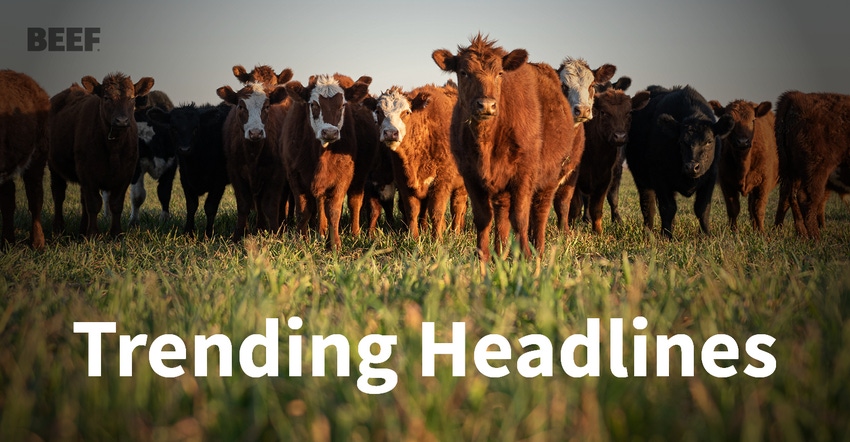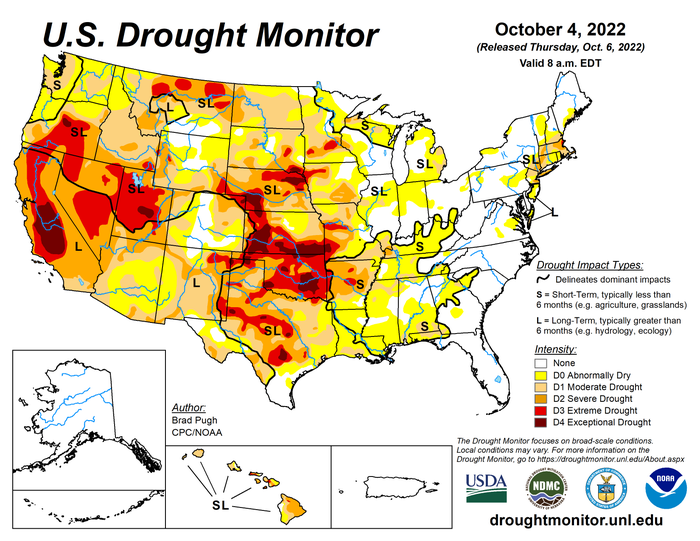Here’s a look at 5 headlines that are on the minds of cattle producers nationwide.

Let’s take a look at 5 headlines from across the USA.
The U.S. Drought Monitor continues to be dominated by red—meaning extreme or exceptional drought out in the western part of the country. Many producers in Oklahoma are giving up on the idea of a spring winter crop to graze on due to the lack of rainfall. In addition, watering areas are drying up with little hope for replenishment anytime soon since they depend on summer thunderstorms for that.


2. Meanwhile in Florida, many producers are struggling to capture their cattle herds after Hurricane Ian.
The storm killed at least 200 cows at a dairy farm in Myakka City, while beef cattle counts remain uncertain until herds can navigate back from swamps and hills where they went to ride out the storm.
“About 42 percent of our Florida cow herd, our cattle population in the state was affected by this storm,” Florida Cattlemen’s Association Executive Vice President Jim Handley said.
Handley said he couldn’t give an estimate on the full impact to the industry, as ranchers scramble for feed and continue to make emergency repairs to fences and buildings.
3. New Zealand’s government on Tuesday proposed taxing the greenhouse gasses that farm animals make from burping and peeing as part of a plan to tackle climate change.
The government said the farm levy would be a world first, and that farmers should be able to recoup the cost by charging more for climate-friendly products.
But farmers quickly condemned the plan. Federated Farmers, the industry’s main lobby group, said the plan would “rip the guts out of small-town New Zealand” and see farms replaced with trees.
Federated Farmers President Andrew Hoggard said farmers had been trying to work with the government for more than two years on an emissions reduction plan that wouldn’t decrease food production.
Opposition lawmakers from the conservative ACT Party said the plan would actually increase worldwide emissions by moving farming to other countries that were less efficient at making food.
4. The wagyu beef market will be driven by factors such as the growing inventory of wagyu beef in Japan. In May 2020, under the Beef Livestock Stabilization Program called Marukin, the Government of Japan announced that it would issue support payments to cattle producers of wagyu beef. Under this program, the government will pay the producers of wagyu cattle 90% of the difference between revenue and production costs, which is recalculated per month. Such initiatives will drive the market during the forecast period.
The wagyu beef market size is anticipated to grow by USD 3.57 billion. In addition, the growth momentum of the market will accelerate at a CAGR of 7.4% during the forecast period.
5. And the wolves are back in the news. Wolves from two packs in northeast Washington state have attacked more cattle, prompting the Department of Fish and Wildlife to consider whether to again try culling the Smackout pack after a botched attempt last month.
Fish and Wildlife officials confirmed last week that the Smackout pack wounded a calf in a private Stevens County pasture, the Capital Press reported. Officials said the pack also injured a calf Monday and probably attacked another on Sept. 26.The pack has attacked at least 11 head of cattle since Aug. 17, according to Fish and Wildlife's count.
As of Dec. 31, 2021, the department said 206 wolves in 33 packs lived in Washington. The numbers grew from 2020, when 178 wolves in 29 packs were counted.
About the Author(s)
You May Also Like



